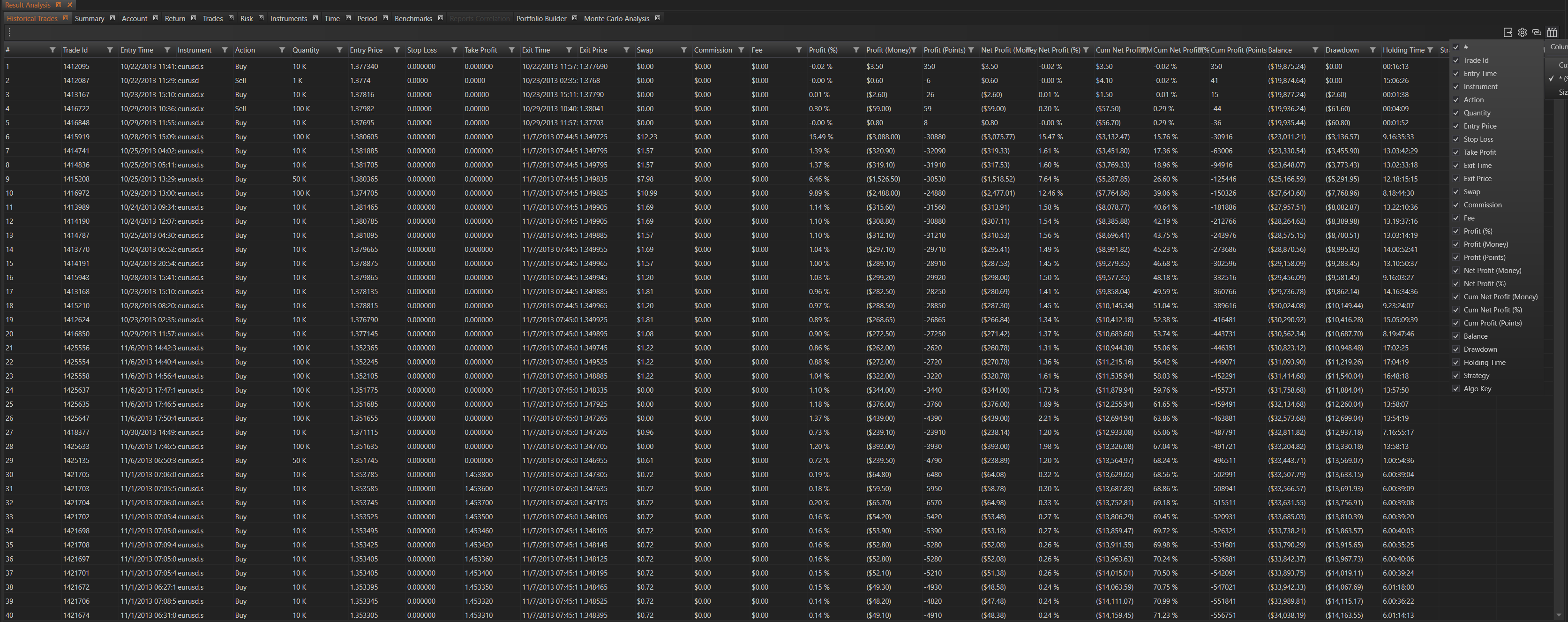- Accounts & Connection Management
- Data Management & Analysis
- Price Monitoring
- Charting
- Trading
- Scanners
-
Builders
-
Manual Strategy Builder
- Main Concept
- Operand Component
- Algo Elements
-
Use Cases
- How to create a condition on something crossing something
- How to create an indicator based on another indicator
- How to calculate a stop loss based on indicator
- How to submit stop order based on calculated price
- How to calculate a current bar price using a price type from inputs
- How to Use a Closed Bar Price
- Automatic Strategy Builder
-
Manual Strategy Builder
- Autotrading
- FinScript
- Trade Analysis
- Media Feeds
- Logs & Notifications
- UI & UX
The Historical Trades section within the Result Analysis module offers an in-depth examination of each trade's details through a comprehensive grid. This grid captures various aspects of each trade, providing essential information for traders to analyze their performance and strategies.

Columns
- #: A unique identifier for each record in the historical trades table, helping to distinguish individual trades.
- Trade Id: A unique identifier for the trade, used to track and reference specific trades.
- Entry Time: The date and time when the trade position was opened, providing context for market conditions at the time of entry.
- Instrument: The financial instrument involved in the trade, indicating what was traded (e.g., stocks, forex, commodities).
- Action: The direction of the trade, with "Buy" indicating a long position and "Sell" indicating a short position.
- Quantity: The number of units traded, reflecting the size of the trade.
- Entry Price: The price at which the position was opened, showing the initial cost per unit.
- Stop Loss: The predefined price level to limit potential losses, set to close the trade if the market moves unfavorably.
- Take Profit: The predefined price level to lock in gains, set to close the trade once a certain profit is achieved.
- Exit Time: The date and time when the trade position was closed, marking the end of the trade.
- Exit Price: The price at which the position was closed, indicating the final selling or buying price per unit.
- Commission: The amount paid as commission for executing the trade, impacting overall profitability.
- Fee: Any additional fees associated with the trade, further affecting the net profit.
- Swap: The overnight holding fee for keeping a position open, relevant for trades held over multiple days.
- Profit (Money): The monetary profit or loss from the trade, calculated in the account's currency.
- Profit (Points): The profit or loss in points, reflecting the price movement favorability.
- Profit (%): The profit or loss as a percentage of the initial capital, providing a relative measure of performance.
- Net Profit (Money): The profit after deducting Commission, Fee, and Swap, offering a clearer view of the actual earnings.
- Net Profit (%): The net profit as a percentage of the initial capital, highlighting the efficiency of the trade.
- Cum Net Profit (Money): The cumulative net profit over a series of trades, showing overall profitability in monetary terms.
- Cum Net Profit (%): The cumulative net profit as a percentage of the initial capital, indicating the overall return on investment.
- Cum Profit (Points): The cumulative profit in points across multiple trades, providing a broader view of performance.
- Balance: The account balance after the trade was closed, showing the impact of the trade on the overall account.
- Drawdown: The peak-to-trough decline during the trade, calculated as the sum of drawdowns from previous trades and Net Profit if positive, or zero otherwise.
- Holding Time: The total duration the position was held, useful for understanding the time-based performance.
- Strategy: The name of the trading strategy that initiated the trade, linking the trade to specific trading methods.
- Algo Key: A unique key identifying the algorithm or automated strategy that initiated the trade, important for evaluating automated trading performance.
This detailed information helps traders to conduct a thorough analysis of their trades, identify strengths and weaknesses in their strategies, and make data-driven decisions to enhance their trading outcomes.
- Accounts & Connection Management
- Data Management & Analysis
- Price Monitoring
- Charting
- Trading
- Scanners
-
Builders
-
Manual Strategy Builder
- Main Concept
- Operand Component
- Algo Elements
-
Use Cases
- How to create a condition on something crossing something
- How to create an indicator based on another indicator
- How to calculate a stop loss based on indicator
- How to submit stop order based on calculated price
- How to calculate a current bar price using a price type from inputs
- How to Use a Closed Bar Price
- Automatic Strategy Builder
-
Manual Strategy Builder
- Autotrading
- FinScript
- Trade Analysis
- Media Feeds
- Logs & Notifications
- UI & UX